Adsorption/Desorption Capability of Potassium-Type Zeolite Prepared from Coal Fly Ash for Removing of Hg2+
Abstract
1. Introduction
2. Materials and Methods
2.1. Materials
2.2. Amount of Hg2+ Adsorbed Using FA Series
2.3. Effect of pH, Temperature, and Contact Time on the Adsorption of Hg2+
2.4. Effect of Coexistences on the Adsorption of Hg2+
2.5. Adsorption/Desorption of Hg2+ Using Sodium Hydroxide Solution
3. Results and Discussion
3.1. Properties of Potassium-Type Zeolite
3.2. Adsorption of Hg2+
3.3. Adsorption Isotherms of Hg2+
3.4. Effect of Solution pH on the Adsorption of Hg2+
3.5. Effect of Contact Time on the Adsorption of Hg2+
3.6. Selectivity for Hg2+ Removal from Binary Solution System
3.7. Adsorption/Desorption Capability of Hg2+ Using FA48
4. Conclusions
Author Contributions
Funding
Institutional Review Board Statement
Informed Consent Statement
Data Availability Statement
Conflicts of Interest
References
- Sustainable Development Goals, Knowledge Platform. Available online: https://sustainabledevelopment.un.org/sdgs (accessed on 10 June 2020).
- Kragovic, M.; Dakovic, A.; Markovic, M.; Krstic, J.; Gatta, G.D.; Rotiroti, N. Characterization of lead sorption by the natural and Fe(III)-modified zeolite. Appl. Surf. Sci. 2013, 283, 764–774. [Google Scholar] [CrossRef]
- Hamidpour, M.; Kalbasib, M.; Afyunib, M.; Shariatmadarib, H.; Holmic, P.E.; Hansenc, H.C.B. Sorption hysteresis of Cd(II) and Pb(II) on natural zeolite and bentonite. J. Hazard. Mater. 2010, 181, 686–691. [Google Scholar] [CrossRef] [PubMed]
- Volesky, B. Biosorption of Heavy Metals, 4th ed.; CRC Press: Boca Raton, FL, USA, 1990. [Google Scholar]
- Abraham, J.; Dowling, K.; Florentine, S. Assessment of potentially toxic metal contamination in the soils of a legacy mine site in Central Victoria, Australia. Chemosphere 2018, 192, 122–132. [Google Scholar] [CrossRef] [PubMed]
- Fu, Y.; Jiang, J.; Chen, Z.; Ying, S.; Wang, J.; Hu, J. Rapid and selective removal of Hg(II) ions and high catalytic performance of the spent adsorbent based on functionalized mesoporous silica/poly (m-aminothiophenol) nanocomposite. J. Mol. Liq. 2019, 286, 110746. [Google Scholar] [CrossRef]
- Wang, J.; Feng, X.; Anderson, C.W.N.; Xing, Y.; Shang, L. Remediation of mercury contaminated sites—A review. J. Hazard. Mater. 2012, 221, 1–18. [Google Scholar] [CrossRef]
- World Health Organization. Guidelines for Drinking-Water Quality, First Addendum to Volume 1, Recommendations; WHO Press: Geneva, Switzerland, 2006. [Google Scholar]
- IARC Monographs on the Identification of Carcinogenic Hazards to Human. Available online: https://monographs.iarc.fr/list-of-classifications (accessed on 10 June 2020).
- Awual, M.R.; Hasan, M.M.; Eldesoky, G.E.; Khaleque, M.A.; Rahman, M.M.; Naushad, M. Facile mercury detection and removal from aqueous media involving ligand impregnated conjugate nanomaterials. Chem. Eng. J. 2016, 290, 243–251. [Google Scholar] [CrossRef]
- Venkateswarlu, S.; Yoon, M. Surfactant-free green synthesis of Fe3O4 nanoparticles capped with 3,4-dihydroxyphenethylcarbamodithioate: Stable recyclable magnetic nanoparticles for rapid and efficient removal of Hg(II) ions from water. Dalton Trans. 2015, 44, 18427–18437. [Google Scholar] [CrossRef]
- Bukhari, S.S.; Behin, J.; Kazemian, H.; Rohani, S. Conversion of coal fly ash to zeolite utilizing microwave and ultrasound energies: A review. Fuel 2015, 140, 250–266. [Google Scholar] [CrossRef]
- Czarna-Juszkiewicz, D.; Kunecki, P.; Panek, R.; Madej, J.; Wdowin, M. Impact of fly ash fraction on the zeolitization process. Materials 2020, 13, 1035. [Google Scholar] [CrossRef]
- Yao, Z.T.; Ji, X.S.; Sarker, P.K.; Tang, J.H.; Ge, L.Q.; Xia, M.S.; Xi, Y.Q. A comprehensive review on the applications of coal fly ash. Earth Sci. Rev. 2015, 141, 105–121. [Google Scholar] [CrossRef]
- Franus, W.; Wdowin, M.; Franus, M. Synthesis and characterization of zeolites prepared from industrial fly ash. Environ. Monit. Assess. 2014, 186, 5721–5729. [Google Scholar] [CrossRef]
- Blissett, R.S.; Rowson, N.A. A review of the multi-component utilization of coal fly ash. Fuel 2012, 97, 1–23. [Google Scholar] [CrossRef]
- Flores, C.G.; Schneider, H.; Marcillio, N.R.; Ferret, L.; Oliveira, J.C.P. Potassic zeolites from Brazilian coal ash for use as a fertilizer in agriculture. Waste Manag. 2017, 70, 263–271. [Google Scholar] [CrossRef]
- Belviso, C. State-of-the-art applications of fly ash from coal and biomass: A focus on zeolite synthesis processes and issues. Prog. Energy Comb. Sci. 2018, 65, 109–135. [Google Scholar] [CrossRef]
- Medina, A.; Gamero, P.; Almanza, J.M.; Vargas, A.; Montoya, A.; Vargas, G.; Izquierdo, M. Fly ash from a Mexican mineral coal. II. Source of W zeolite and its effectiveness in arsenic (V) adsorption. J. Hazard. Mater. 2010, 181, 91–104. [Google Scholar] [CrossRef]
- Scott, J.; Guang, D.; Naeramitmarnsuk, K.; Thabuot, M.; Amal, R. Zeolite synthesis from coal fly ash for the removal of lead ions from aqueous solution. J. Chem. Technol. Biotechnol. 2001, 77, 63–69. [Google Scholar] [CrossRef]
- Rayalu, S.; Meshram, S.U.; Hasan, M.Z. Highly crystalline faujasitic zeolites from fly ash. J. Hazard. Mater. 2000, 77, 123–131. [Google Scholar] [CrossRef]
- Rios, C.A.; Williams, C.D.; Roberts, C.L. Removal of heavy metals from acid mine drainage (AMD) using coal fly ash, natural clinker and synthetic zeolites. J. Hazard. Mater. 2008, 156, 23–35. [Google Scholar] [CrossRef]
- Tauanov, Z.; Tsakiridis, P.E.; Mikhalovsky, S.V.; Inglezakis, V.J. Synthetic coal fly ash-derived zeolites doped with silver nanoparticles for mercury(II) removal from water. J. Environ. Manag. 2018, 224, 164–171. [Google Scholar] [CrossRef]
- Ma, L.; Han, L.; Chen, S.; Hu, J.; Chang, L.; Bao, W.; Wang, J. Rapid synthesis of magnetic zeolite materials from fly ash and iron-containing wastes using supercritical water for elemental mercury removal from flue gas. Fuel Proc. Technol. 2019, 189, 39–48. [Google Scholar] [CrossRef]
- Qi, L.; Teng, F.; Deng, X.; Zhang, Y.; Zhong, X. Experimental study on adsorption of Hg(II) with microwave-assisted alkali-modified fly ash. Powder Technol. 2019, 341, 153–158. [Google Scholar] [CrossRef]
- Attari, M.; Bukhar, S.S.; Kazemian, H.; Rohani, S. A low-cost adsorbent from coal fly ash for mercury removal from industrial wastewater. J. Environ. Chem. Eng. 2017, 5, 391–399. [Google Scholar] [CrossRef]
- Murayama, N.; Ymamamoto, H.; Shibata, J. Mechansim of zeolite synthesis from coal fly ash by alkali hydrothermal reaction. Int. J. Miner. Process. 2002, 64, 1–17. [Google Scholar] [CrossRef]
- Kobayashi, Y.; Ogata, F.; Saenjum, C.; Nakamura, T.; Kawasaki, N. Removal of Pb2+ from aqueous solutions using K-type zeolite synthesized from coal fly ash. Water 2020, 12, 2375. [Google Scholar] [CrossRef]
- Zhou, Q.; Duan, Y.; Zhu, C.; Zhang, J.; She, M.; Wei, H.; Hong, Y. Adsorption equilibrium, kinetics and mechanism studies of mercury on coal-fired fly ash. Korean J. Chem. Eng. 2015, 32, 1405–1413. [Google Scholar] [CrossRef]
- Okada, Y. Synthesis of zeolite using fly ash on cloased system. Nihon Dojyou Hiryo Gakkaishi 1991, 62, 1–6. [Google Scholar]
- Faria, P.C.C.; Orfao, J.J.M.; Pereira, M.F.R. Adsorption of anionic and cationic dyes on activated carbons with different surface chemistries. Water Res. 2004, 38, 2043–2052. [Google Scholar] [CrossRef]
- Kobayashi, Y.; Ogata, F.; Nakamura, T.; Kawasaki, N. Synthesis of novel zeolites produced from fly ash hydrothermal treatment in alkaline solution and its evaluation as an adsorbent for heavy metal. J. Environ. Chem. Eng. 2020, 8, 103687. [Google Scholar] [CrossRef]
- Shang, Z.; Zhang, L.; Zhao, X.; Liu, S.; Li, D. Removal of Pb(II), Cd(II) and Hg(II) from aqueous solution by mercapto-modified coal gangue. J. Environ. Manag. 2019, 231, 391–396. [Google Scholar] [CrossRef]
- Wang, C.; Tao, S.; Wei, W.; Meng, C.; Liu, F.; Han, M. Multifunctional mesoporous material for detection, adsorption and removal of Hg2+ in aqueous solution. J. Mater. Chem. 2010, 20, 4635–4641. [Google Scholar] [CrossRef]
- Hakami, O.; Zhang, Y.; Banks, C. Thiol-functionalized mesoporous silica-coated magnetite nanoparticles for high efficiency removal and recovery of Hg from water. Water Res. 2012, 46, 3913–3922. [Google Scholar] [CrossRef]
- Lagergren, S. Zur theorie der sogenannten adsorption geloster stoffie. K. Sven. Vetensk. Handl. 1898, 24, 1–39. [Google Scholar]
- Abe, I.; Hayashi, K.; Kitagawa, M. Studies on the adsorption of surfactants on activated carbons. I. Adsorption of nonionic surfactants. Yukagaku 1976, 25, 145–150. [Google Scholar]
- Ho, Y.S.; McKay, G. Pseudo-second order model for sorption process. Process Biochem. 1999, 34, 451–465. [Google Scholar] [CrossRef]
- Kumar, V. Adsorption kinetics and isotherms for the removal of rhodamine B dye and Pb2+ ions from aqueous solutions by a hybrid ion-exchanger. Arab. J. Chem. 2019, 12, 316–329. [Google Scholar]
- Foo, K.Y.; Hameed, B.H. Insights into the modeling of adsorption isotherms systems. Chem. Eng. J. 2010, 156, 2–10. [Google Scholar] [CrossRef]
- Kumara, N.T.R.N.; Hamdan, N.; Peter, M.I.; Tennakoon, K.T.; Ekanayake, P. Equilibrium isotherm studies of adsorption of pigments extracted from Kuduk-kuduk (Melastoma malabathricum L.) pulp onto TiO2 nanoparticles. J. Chem. 2014, 2014, 468975. [Google Scholar] [CrossRef]
- Liu, U.; Li, Q.; Cao, X.; Wang, Y.; Jiang, X.; Li, M.; Hua, M.; Zhang, Z. Removal of uranium(VI) from aqueous solutions by CMK-3 and its polymer composite. Chem. Eng. 2013, 285, 258–266. [Google Scholar] [CrossRef]
- Zhang, F.S.; Nriagu, J.O.; Itoh, H. Mercury removal from water using activated carbons derived from organic sewage sludge. Water Res. 2005, 39, 389–395. [Google Scholar] [CrossRef]
- Arisa, F.E.; Beneduci, A.; Chidichimo, F.; Furia, E.; Straface, S. Study of the adsorption of mercury (II) on lignocellulosic materials under static and dynamic conditions. Chemosphere 2017, 180, 11–23. [Google Scholar]
- Boparai, H.K.; Joseph, M.; O’Carroll, D.M. Kinetics and thermodynamics of cadmium ion removal ion removal by adsorption onto nano zerovalent iron particles. J. Hazard. Mater. 2011, 186, 458–465. [Google Scholar] [CrossRef] [PubMed]
- Robati, D. Pseudo-second-order kinetic equations for modeling adsorption systems for removal of lead ions using multi-walled carbon nanotube. J. Nanostructure Chem. 2013, 3, 55. [Google Scholar] [CrossRef]
- Wu, F.C.; Tseng, R.L.; Juang, R.S. Characteristics of Elovic equation used for the analysis of adsorption kinetics in dye-chitosan systems. Chem. Eng. J. 2009, 150, 366–373. [Google Scholar] [CrossRef]
- Wang, C.; Hu, X.; Chen, M.L.; Wu, Y.H. Total concentrations and fractions of Cd, Cr, Pb, Cu, Ni and Zn in sewage sludge municipal and industrial wastewater treatment plants. J. Hazard. Mater. 2005, B119, 245–249. [Google Scholar] [CrossRef] [PubMed]
- Yadanaparthi, S.K.P.; Graybill, D.; Wandruszka, R.V. Adsorbents for the removal of arsenic, cadmium, and lead from contaminated waters. J. Hazard. Mater. 2009, 171, 1–15. [Google Scholar] [CrossRef] [PubMed]
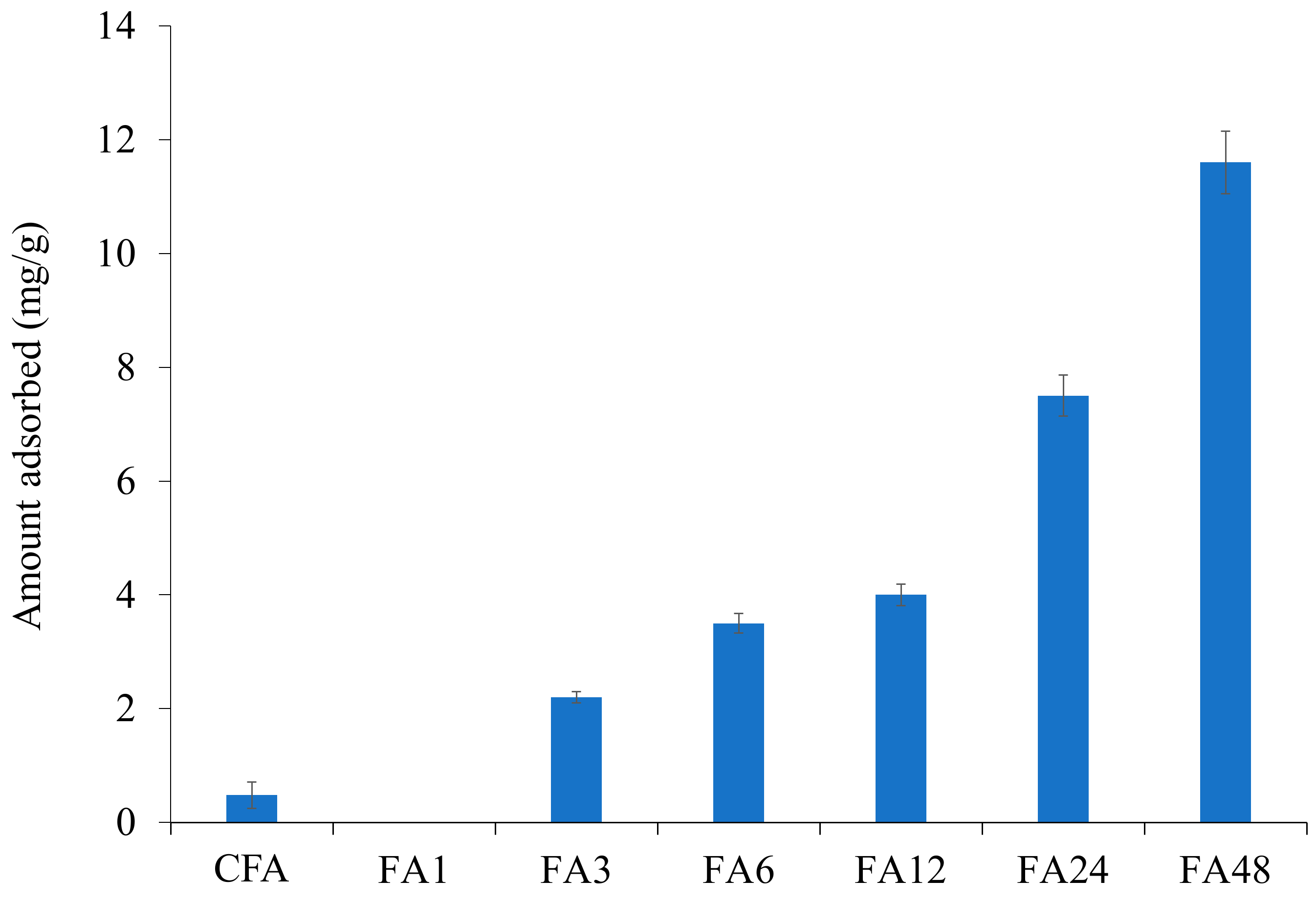
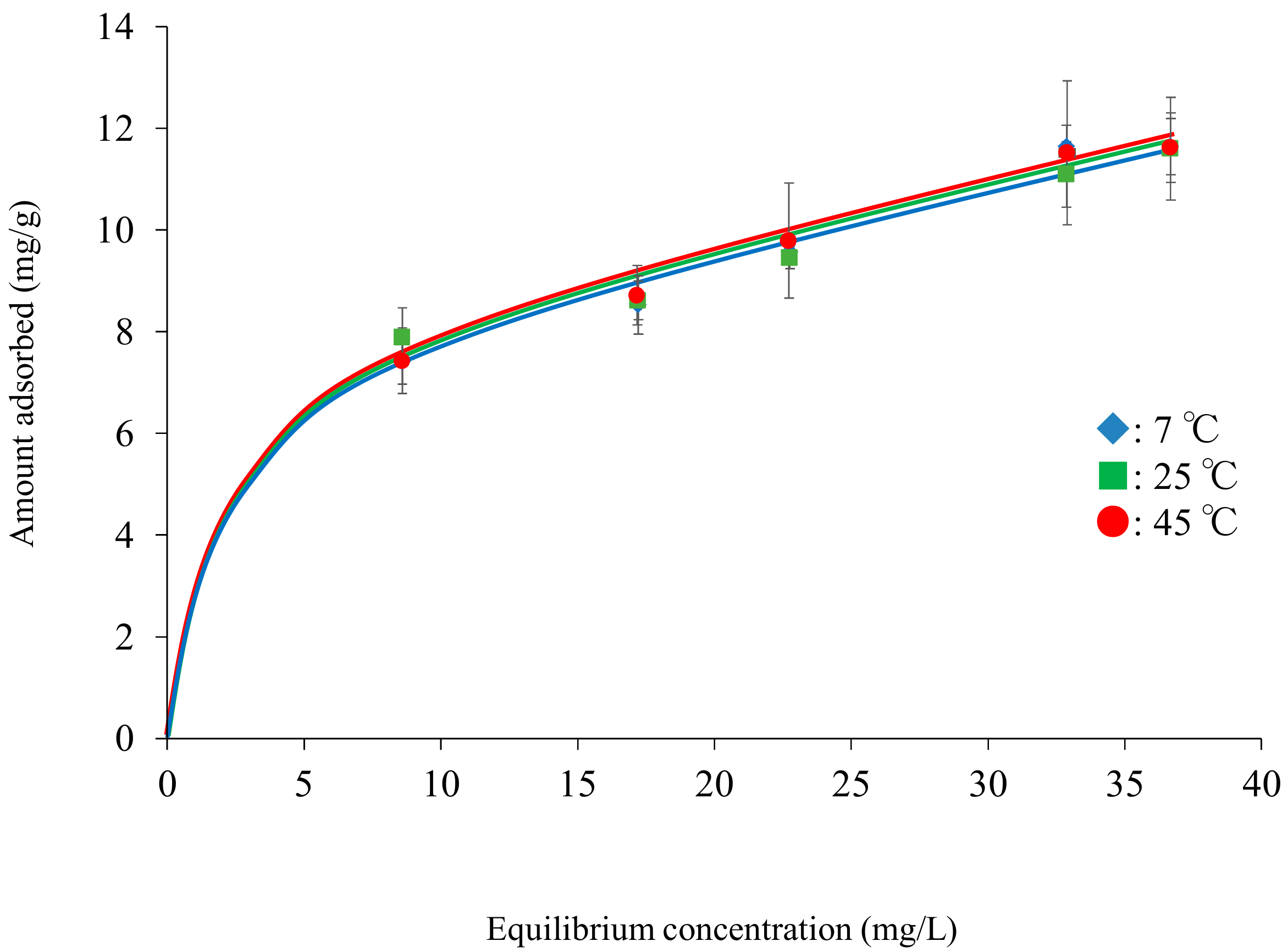
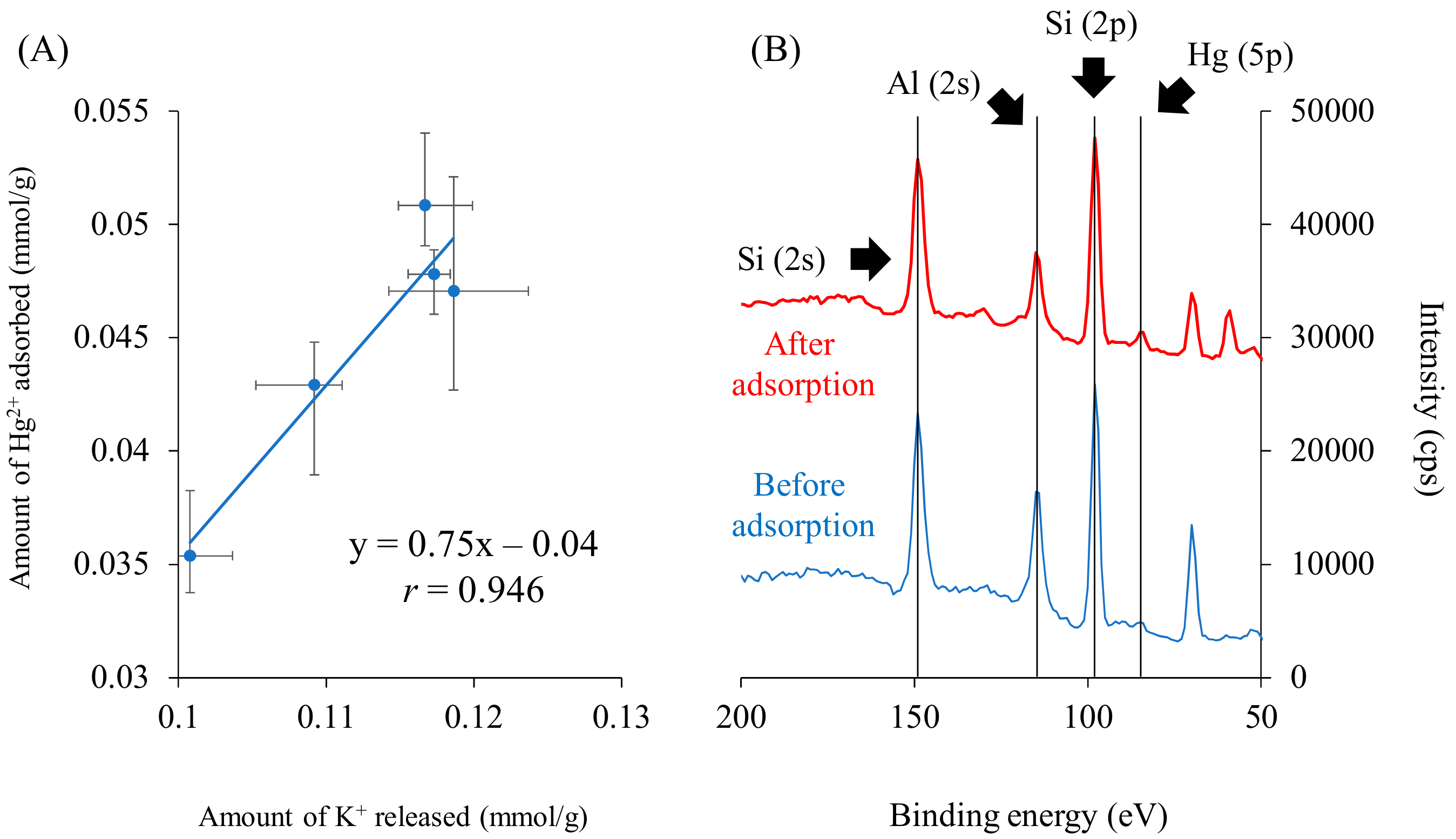

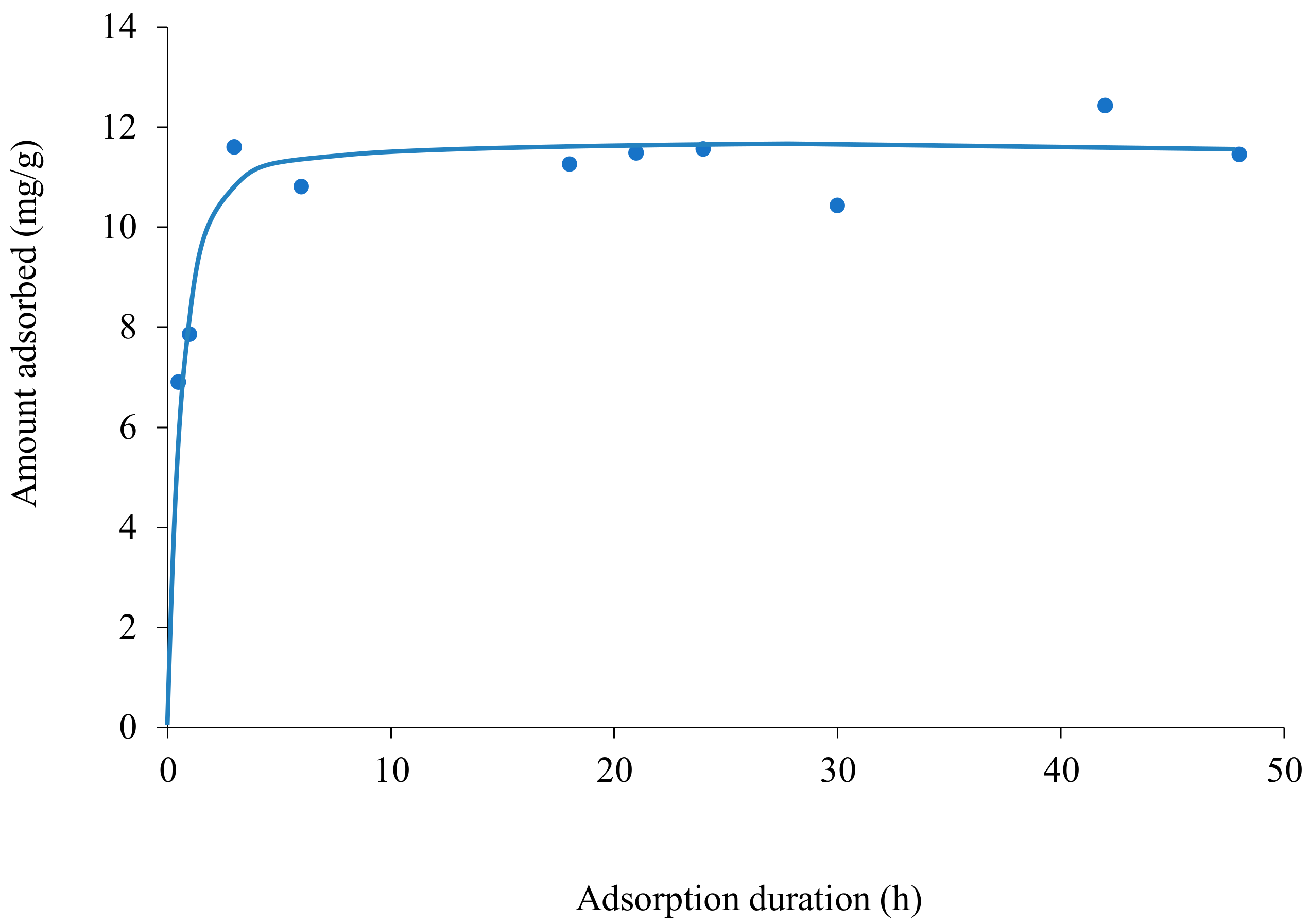
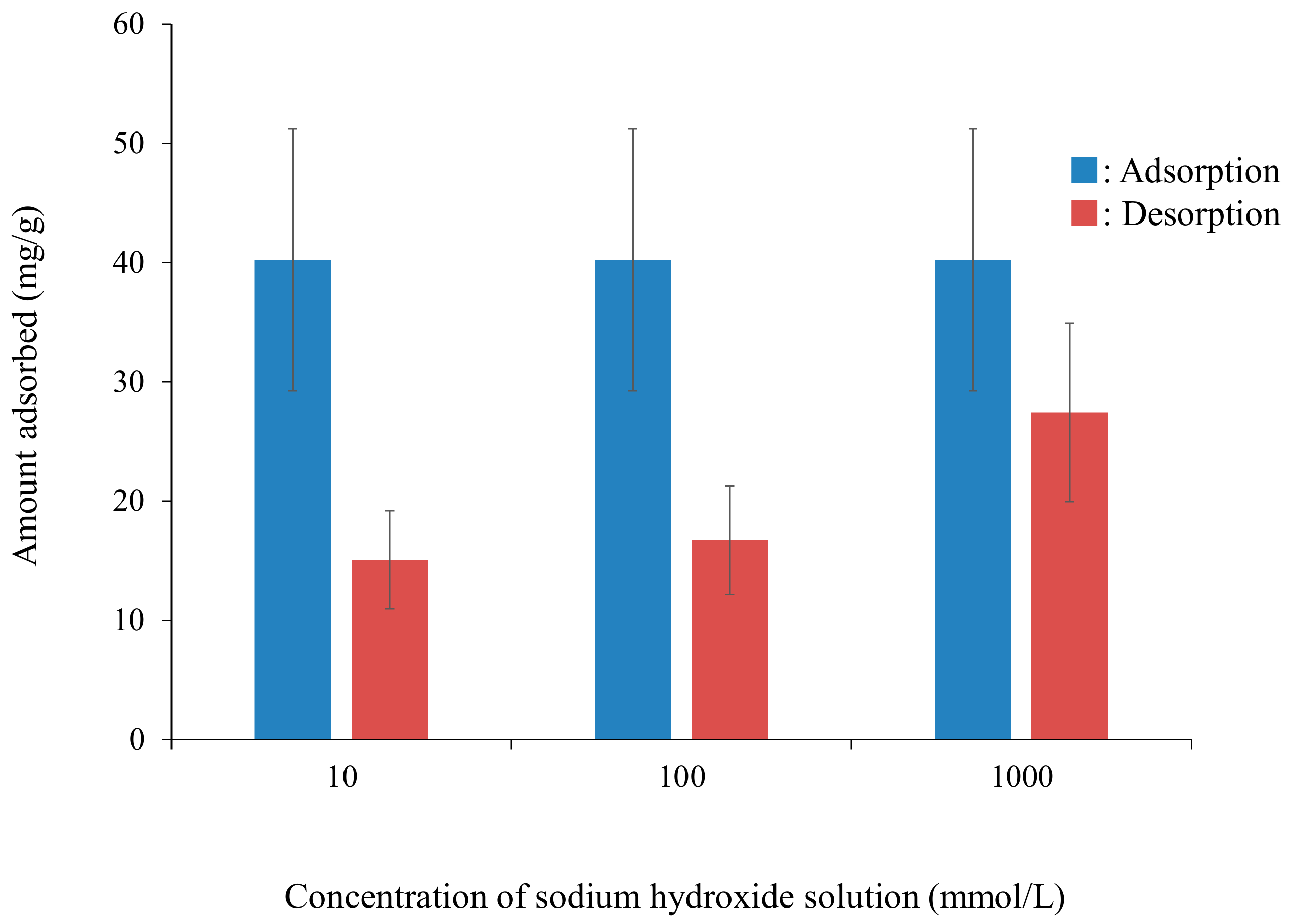
| Adsorbents | CFA | FA1 | FA3 | FA6 | FA12 | FA24 | FA48 | |
|---|---|---|---|---|---|---|---|---|
| CEC (mmol g−1) | pH 5 | 0.34 | 1.98 | 1.17 | 1.63 | 2.27 | 7.90 | 8.98 |
| pH 10 | 0.19 | 0.65 | 1.55 | 2.09 | 3.46 | 11.17 | 11.17 | |
| pHpzc | 9.8 | 9.3 | 9.3 | 9.5 | 9.7 | 10.4 | 10.4 | |
| Specific surface area (m2/g) | 1.4 | 15.1 | 31.5 | 53.3 | 54.5 | 50.3 | 47.3 | |
| Pore volume (µL/g) | d ≦ 20 (Å) | 0.1 | 0.9 | 0 | 0.5 | 0.2 | 10.0 | 10.0 |
| 20 < d ≦ 500 (Å) | 2.0 | 41.9 | 97.4 | 161.5 | 185.0 | 105.0 | 99.0 | |
| Total | 2.2 | 63.0 | 139.0 | 221.0 | 220.0 | 151.0 | 131.0 | |
| Mean pore diameter (Å) | 57.0 | 167.2 | 176.7 | 165.9 | 161.6 | 120.1 | 110.7 | |
| Adsorbents | Adsorption Capability (mg/g) | pH | Temp. (°C) | Initial Concentration (mg/L) | Contact Time (h) | Adsorbent (g/L) | Ref. |
|---|---|---|---|---|---|---|---|
| Coal gangue | 20.0 | 5.5 | 25 | 3.5 | 0.17 | 2.5 | 33 |
| Microwave-assisted alkali-modified fly ash | 2.7 | - | 25 | ~50 | 1.5 | 10 | 24 |
| Raw coal ash zeolite sample | 0.44 | 2.5 | r.t. | 10 | 24 | 1 | 26 |
| Multifunctional mesoporous material | 21.05 | Not provided | 25 | Not provided | 2 | Not provided | 34 |
| Thiol-functionalized mesoporous silica-coated magnetite nanoparticle | 9.5 | 6.0 | 22.5 | 8 | 15 | 8.0 × 10−5 | 35 |
| Sodium-type zeolite prepared from fly ash | 7.5 | 3.0 | 25 | 10 | 24 | 0.2 | 32 |
| FA48 | 11.6 | 3.0 | 25 | 50 | 24 | 0.2 | This study |
| Sample | Temp. (°C) | Langmuir Constants | Freundlich Constants | ||||
|---|---|---|---|---|---|---|---|
| qmax (mg/g) | KL (L/mg) | r | logKF | 1/n | r | ||
| FA48 | 7 | 13.25 | 0.14 | 0.942 | 0.55 | 0.33 | 0.977 |
| 25 | 12.27 | 0.19 | 0.904 | 0.63 | 0.27 | 0.960 | |
| 45 | 13.35 | 0.14 | 0.962 | 0.56 | 0.32 | 0.989 | |
| Sample | Temp. (°C) | KS (L/mg) | Qmax (mg/g) | n | r |
|---|---|---|---|---|---|
| FA48 | 7 | 0.84 | 11.6 | 1.1 | 0.959 |
| 25 | 19.4 | 11.6 | 0.6 | 0.858 | |
| 45 | 4.1 × 102 | 11.6 | 0.4 | 0.841 |
| Adsorbents | qe,exp | Pseudo-First-Order Model | Pseudo-Second-Order Model | ||||
|---|---|---|---|---|---|---|---|
| k1 (1/h) | qe,cal (mg/g) | r | k2 (g/mg/h) | qe,cal (mg/g) | r | ||
| FA48 | 12.42 | 0.02 | 2.34 | 0.515 | 0.085 | 11.7 | 0.996 |
| Components in Binary Solution | Removal Percentage of Hg2+ (%) | Removal of Other Cations (%) |
|---|---|---|
| Hg2+ + Na+ | 4.6 | 0 |
| Hg2+ + Mg2+ | 11.4 | 0 |
| Hg2+ + K+ | 5.1 | 0 |
| Hg2+ + Ca2+ | 11.9 | 0 |
| Hg2+ + Ni+ | 16.2 | 0.1 |
| Hg2+ + Cu2+ | 12.9 | 2.4 |
| Hg2+ + Zn2+ | 16.0 | 1.3 |
| Hg2+ + Sr2+ | 15.9 | 0 |
| Hg2+ + Cd2+ | 14.4 | 1.8 |
Publisher’s Note: MDPI stays neutral with regard to jurisdictional claims in published maps and institutional affiliations. |
© 2021 by the authors. Licensee MDPI, Basel, Switzerland. This article is an open access article distributed under the terms and conditions of the Creative Commons Attribution (CC BY) license (https://creativecommons.org/licenses/by/4.0/).
Share and Cite
Kobayashi, Y.; Ogata, F.; Saenjum, C.; Nakamura, T.; Kawasaki, N. Adsorption/Desorption Capability of Potassium-Type Zeolite Prepared from Coal Fly Ash for Removing of Hg2+. Sustainability 2021, 13, 4269. https://doi.org/10.3390/su13084269
Kobayashi Y, Ogata F, Saenjum C, Nakamura T, Kawasaki N. Adsorption/Desorption Capability of Potassium-Type Zeolite Prepared from Coal Fly Ash for Removing of Hg2+. Sustainability. 2021; 13(8):4269. https://doi.org/10.3390/su13084269
Chicago/Turabian StyleKobayashi, Yuhei, Fumihiko Ogata, Chalermpong Saenjum, Takehiro Nakamura, and Naohito Kawasaki. 2021. "Adsorption/Desorption Capability of Potassium-Type Zeolite Prepared from Coal Fly Ash for Removing of Hg2+" Sustainability 13, no. 8: 4269. https://doi.org/10.3390/su13084269
APA StyleKobayashi, Y., Ogata, F., Saenjum, C., Nakamura, T., & Kawasaki, N. (2021). Adsorption/Desorption Capability of Potassium-Type Zeolite Prepared from Coal Fly Ash for Removing of Hg2+. Sustainability, 13(8), 4269. https://doi.org/10.3390/su13084269






